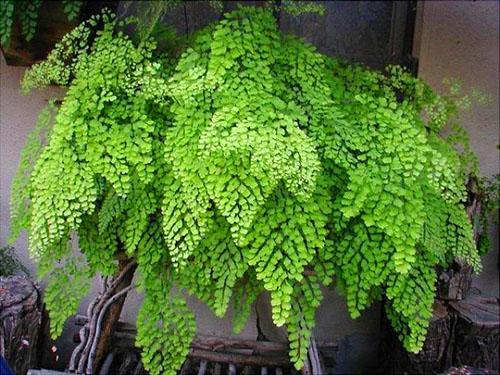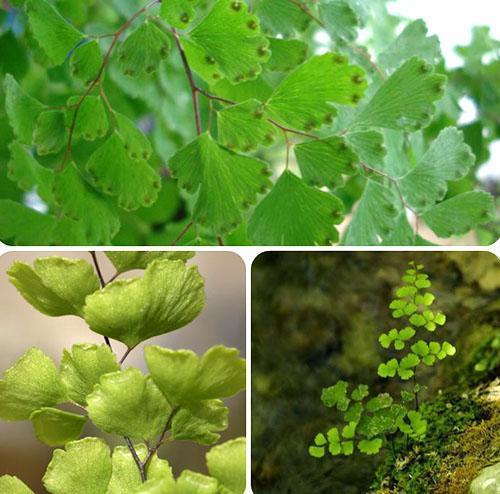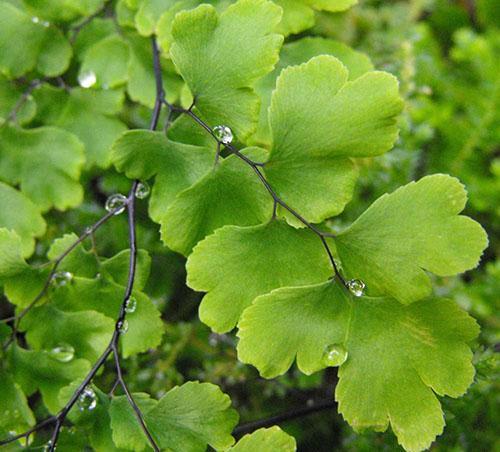Do you know how the maidenhair Venus of hair multiplies?
 Ferns, a special type of plant that are distributed almost all over the globe, where mosses live, in damp places and on rocks. They can settle in a damp crevice, in dark depressions, they prefer alkaline soils with a high content of salts based on carbonic acid and carbonates. The maidenhair venus hair is one of the many fern species.
Ferns, a special type of plant that are distributed almost all over the globe, where mosses live, in damp places and on rocks. They can settle in a damp crevice, in dark depressions, they prefer alkaline soils with a high content of salts based on carbonic acid and carbonates. The maidenhair venus hair is one of the many fern species.
Biological features of the structure of the vegetative organs of the maidenhair

The maidenhair venus hair has a rhizome that spreads over the top layer of the soil, conquering space and populating crevices between the rocks. The root is protected from the outside by black sheets arranged scaly. Fern leaves rise 60 cm above the ground, forming a picturesque carpet in nature.
An interesting property of the maidenhair is to remain dry in the heaviest rain. Raindrops do not wet the plant, but flow from it. This sign is used in the Latin name. It translates as dry stalk, another name for a flower.
 The leaves of the maidenhair venus hair have a peculiar shape. They are located on almost black petioles. The petioles are thin and hair-like. Leaves are located on these long, up to 25 cm petioles. Sometimes the petioles are dissected and form a complex plate, but all these numerous black hairs end with curls, which are small leaves called fronds. The leaf blades reach 40 cm, they are cut twice into two or three segments. Each leaf, called a segment of the last order, has a delicate plate of various shapes, but always with denticles.
The leaves of the maidenhair venus hair have a peculiar shape. They are located on almost black petioles. The petioles are thin and hair-like. Leaves are located on these long, up to 25 cm petioles. Sometimes the petioles are dissected and form a complex plate, but all these numerous black hairs end with curls, which are small leaves called fronds. The leaf blades reach 40 cm, they are cut twice into two or three segments. Each leaf, called a segment of the last order, has a delicate plate of various shapes, but always with denticles.
 At the edges of the leaves, covered, sori develop, cradles for the development of spores, which are the seeds of the maidenhair, used in reproduction. When the spores are ripe, the sori open up, and the wind can carry the seed to a favorable place. Sporulation in ferns occurs during the entire growing season.
At the edges of the leaves, covered, sori develop, cradles for the development of spores, which are the seeds of the maidenhair, used in reproduction. When the spores are ripe, the sori open up, and the wind can carry the seed to a favorable place. Sporulation in ferns occurs during the entire growing season.
 You can collect spores from a home plant yourself or buy a bag of spores from the store, which will be called seeds. We love the maidenhair flower venus hair, it is often used in home breeding because of the delicate greenery and the rapid growth of the green mass, but the plant is demanding to care for.
You can collect spores from a home plant yourself or buy a bag of spores from the store, which will be called seeds. We love the maidenhair flower venus hair, it is often used in home breeding because of the delicate greenery and the rapid growth of the green mass, but the plant is demanding to care for.
Conditions of keeping adiantums
 In order for a plant to please with its bright greenery, you will need to reckon with its preferences. The main conditions of detention will be the creation of conditions approaching natural:
In order for a plant to please with its bright greenery, you will need to reckon with its preferences. The main conditions of detention will be the creation of conditions approaching natural:
- lighting;
- watering and fertilizing;
- temperature regime;
- soil and transplant.
An important role in the decorativeness of a plant is played by the choice of a place of keeping. It is for the fern that the north window is ideal. The maidenhair flower does not like bright sunlight. His fronds turn pale and dry. Where it is light and warm, you can place the maidenhair flower on the shelves.
Summer temperature should not exceed 24 0, and above 20, the plant needs to be provided with high humidity.In winter, maidenhair is kept in a cool room with a temperature of 10-15 degrees, but at the lower limit, the growth of green mass stops.
 Watering plentiful, daily, without stagnant water. Bottom moistening is the best way until moisture comes out on top. Then the plant is given the opportunity to dump excess moisture through the drainage, avoiding stagnation.
Watering plentiful, daily, without stagnant water. Bottom moistening is the best way until moisture comes out on top. Then the plant is given the opportunity to dump excess moisture through the drainage, avoiding stagnation.
You can create moisture in the environment by placing an aquarium, a humidifier or a tray with pebbles, moss, expanded clay with a large evaporation surface nearby. To create the desired microclimate, the plant must be sprayed. The plates will remain dry, but the mist collected in droplets will evaporate for a long time. The plant is the best suited for inclusion in the composition of a winter garden on a heated loggia or a heated balcony.
Reproduction and transplantation of the maidenhair
 Choosing the right nutrient mixture will be important for the nutrition of any indoor flower. For transplanting maidenhair, a composition is used that is different from the soil for young plants or sowing. The flower does not tolerate transplants well, therefore, it is better not to touch the roots without special need, to transfer the plant to a large container, to compact the earth by pouring it with the subsequent pouring of a new portion.
Choosing the right nutrient mixture will be important for the nutrition of any indoor flower. For transplanting maidenhair, a composition is used that is different from the soil for young plants or sowing. The flower does not tolerate transplants well, therefore, it is better not to touch the roots without special need, to transfer the plant to a large container, to compact the earth by pouring it with the subsequent pouring of a new portion.
The best time for transplanting with a revision of the roots is spring, the time when young fronds are just beginning to appear. When transplanting, dividing or reproducing maidenhair spores, the room should be warm, 16-20 degrees.
 To transplant an old plant, take soil:
To transplant an old plant, take soil:
- sod land - 2 parts;
- peat - 3 parts;
- leaf land - 3 parts;
- humus or biohumus - 1 part;
- sand - 1 part.
The prepared soil must necessarily undergo disinfection in order to kill spores, bacteria and mycelium, which, under favorable conditions, can destroy an adult plant and new plants.
For young plants, the sod composition is excluded, and for the cultivation of maidenhair from seeds, a composition of sand, peat, leafy earth is prepared in a ratio of 2: 1: 1.
 In practice, reproduction is not carried out by dividing the bush, but by spores that can be obtained from the plant or bought. They are also called seeds. Ferns do not have other seeds, since flowering plants are described only in legends. Delenki take root for a long time, and the bush loses its decorative effect if it is disturbed.
In practice, reproduction is not carried out by dividing the bush, but by spores that can be obtained from the plant or bought. They are also called seeds. Ferns do not have other seeds, since flowering plants are described only in legends. Delenki take root for a long time, and the bush loses its decorative effect if it is disturbed.
 In order to grow a new maidenhair from spores, a little patience is required, but the plant will turn out to be stronger and healthier.
In order to grow a new maidenhair from spores, a little patience is required, but the plant will turn out to be stronger and healthier.
- Collect spores from the drop-down sori on the bottom of the frond onto a piece of paper with a sharp instrument.
- Place the prepared container on a warm surface, creating a temperature of 20-22 0closing the container with glass. Ventilate from time to time to prevent mold from forming.
- Seedlings may appear in 5 weeks, and may develop 3 months, but the surface will be covered with a green rug. Until this time, the box can stand in a dark, warm place.
- Expose the seedlings to the light, remove the cover and wait until they can be thinned and planted. Initially, leave 2.5 cm between the plants, later plant the plants in separate cups, you can several pieces at a distance.
 When choosing a pot for further cultivation, you need to stay on a wide and deep bowl, since the root of the plant is creeping. At the same time, the dishes should be commensurate with the development of the root system. The first cup for babies is chosen 7 cm in diameter. Requirements for an annual soil change and transfer to a large container for the plant are mandatory.
When choosing a pot for further cultivation, you need to stay on a wide and deep bowl, since the root of the plant is creeping. At the same time, the dishes should be commensurate with the development of the root system. The first cup for babies is chosen 7 cm in diameter. Requirements for an annual soil change and transfer to a large container for the plant are mandatory.
 During the growing season in the spring and summer, the plant should be fed with fern fertilizers. Their peculiarity is that they are based on organic matter. Fern does not like mineral salts. Therefore, when watering, the water should be soft, without unnecessary additives, warm. Subject to all conditions, a fast-growing perennial flower will delight with its appearance all year round.
During the growing season in the spring and summer, the plant should be fed with fern fertilizers. Their peculiarity is that they are based on organic matter. Fern does not like mineral salts. Therefore, when watering, the water should be soft, without unnecessary additives, warm. Subject to all conditions, a fast-growing perennial flower will delight with its appearance all year round.